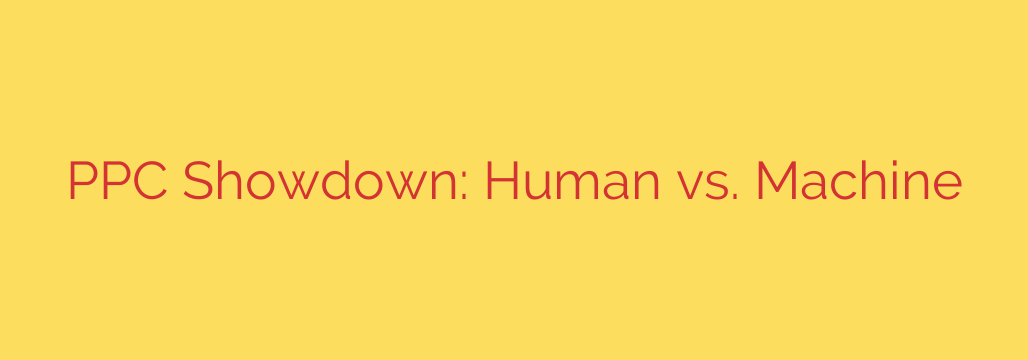
Human vs. AI in PPC: The Winning Strategy for Modern Advertisers
In the world of pay-per-click (PPC) advertising, a major debate is unfolding: can sophisticated AI and machine learning replace the strategic mind of a human campaign manager? While automation offers incredible efficiency and data-processing power, human intuition and creativity remain indispensable. The truth is, the most successful PPC campaigns aren’t about choosing one over the other.
The ultimate victory lies in a powerful partnership. Understanding the unique strengths of both human experts and AI tools is the key to maximizing your return on ad spend (ROAS) and achieving sustainable growth.
The Indispensable Role of Human Expertise
Even the most advanced algorithm can’t replicate the nuanced understanding of a seasoned PPC professional. Human intelligence is crucial for the foundational elements of any successful campaign.
Strategic Oversight and Context: AI is excellent at optimizing within the parameters it’s given, but it can’t set the overarching strategy. A human manager understands the broader business goals, competitive landscape, and market sentiment. They can interpret a sudden drop in performance not just as a data point, but as a potential consequence of a new competitor, a PR issue, or a shift in consumer behavior. This contextual understanding is something machines currently lack.
Creative Ingenuity and Brand Voice: Ad copy and creative assets are designed to evoke an emotional response and connect with an audience. Humans excel at crafting compelling narratives, using persuasive language, and ensuring every ad perfectly reflects the brand’s unique voice and values. AI can generate variations, but it cannot originate true creativity or understand the subtle cultural nuances that make an ad resonate.
Complex Problem-Solving: When a campaign goes off the rails, it takes a human to diagnose the root cause. Is it a broken landing page? A flawed value proposition? An issue with the product itself? AI can flag the symptom (e.g., low conversion rate), but a human expert performs the holistic analysis to identify and fix the core problem, which often lies outside the ad platform itself.
The Unstoppable Power of AI and Automation
While humans set the strategy, AI and machine learning are the engines that drive performance at a scale no human team could ever manage.
Unparalleled Data Processing: Modern PPC campaigns generate a staggering amount of data. AI can analyze thousands of signals—time of day, device, location, audience demographics, past behavior—in real-time for every single auction. This data analysis at scale allows for incredibly precise targeting and optimization that is simply beyond human capability.
Real-Time Bid Optimization: Automated bidding strategies, like Google’s Smart Bidding, use machine learning to optimize for conversions or conversion value in every auction. This means your bids are adjusted on the fly to be as competitive and cost-effective as possible. Relying on manual bidding for large-scale campaigns is inefficient and often leads to missed opportunities. AI ensures you are paying the right price for every click.
Efficient A/B Testing at Scale: Want to know which headline works best with which description and which landing page? AI can rapidly create, deploy, and analyze thousands of ad variations simultaneously. This allows for continuous improvement and data-driven decision-making on ad creative, removing guesswork and personal bias from the equation.
The Winning Formula: A Hybrid Approach
The “human vs. machine” debate presents a false choice. The most dominant and profitable PPC strategies merge human intellect with machine efficiency. This synergistic model creates a continuous loop of improvement.
Here’s how to structure a winning hybrid PPC strategy:
Humans Define the Strategy (The “Why”): The marketing team sets the campaign goals (e.g., lead generation, e-commerce sales, brand awareness), defines the target audience personas, establishes the budget, and crafts the core messaging and creative direction.
AI Executes and Optimizes (The “How”): Once the strategic framework is in place, AI-powered tools are deployed. They manage the real-time bidding, identify new audience segments, test ad combinations, and allocate the budget to the best-performing areas of the campaign.
Humans Analyze and Refine (The “What’s Next”): The human manager’s role shifts from minute-to-minute tactical adjustments to high-level analysis. They review the performance data provided by the AI to identify trends and insights. They ask critical questions: Is the AI optimizing for the right kind of customer? Are the insights from the campaign informing our broader marketing strategy?
Create a Continuous Feedback Loop: The insights gained from human analysis are used to refine the overall strategy. For example, if the AI discovers a surprisingly profitable new audience segment, the human strategist can then build dedicated creative and landing pages to better serve that group. This human insight guides the AI toward smarter, more profitable goals.
Ultimately, the future of PPC isn’t about replacing humans with machines. It’s about empowering humans with machines. By leveraging AI for what it does best—processing data and automating tasks—PPC professionals are freed up to focus on what they do best: strategy, creativity, and big-picture thinking. This powerful collaboration is the definitive winning strategy for any advertiser looking to dominate in today’s competitive digital landscape.
Source: https://www.simplilearn.com/man-vs-machine-whos-winning-at-ppc-article








